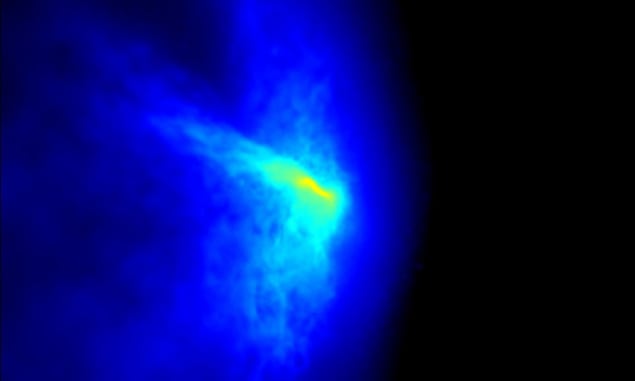
Supersonic streams of gas could have triggered the birth of supermassive black holes in the early universe. That is the implication of hydrodynamic simulations done by Shingo Hirano of the University of Texas at Austin and colleagues. The research could explain how huge black holes were able to form when the universe was less than one billion years old.
Supermassive black holes have masses millions to billions of times that of the Sun and lurk at the centres of nearby large galaxies. While these behemoths have had billions of years to form, astronomers also know that supermassive black holes have powered quasars less than a billion years after the Big Bang. These early sightings are a mystery because astronomers do not have a good explanation of how these huge objects could have formed so quickly in the early universe.
One leading hypothesis is that enormous clouds of gas collapsed under the force of their own gravity, condensing directly into a black hole. However, scientists have struggled to model how enough gas can fall into the cloud to build up its mass before the cloud fragments to form stars. Now, work by Hirano and colleagues suggests that high-velocity streams of gas can quickly build up a gas cloud’s mass, facilitating its collapse.
The streams have their origins in the epoch of recombination, which occurred about 378,000 years after the Big Bang. This was when the cosmic microwave background radiation was emitted and baryonic matter and radiation become decoupled, allowing photons to travel unhindered through the universe. The decoupling set baryonic matter such as gas in motion, but not dark matter (which does not interact with light). Therefore, ordinary matter adopted streaming motions relative to the haloes of dark matter, inside which gas clouds congregated and the first stars and galaxies formed.
Counteracting feedback
In its simulations, Hirano’s team shows that the streaming motions initially prevented gas from settling inside dark-matter haloes. However, the haloes soon grew more massive and, about 100 million years after the Big Bang, the dark-matter halo in the team’s simulation had grown to 22 million solar masses, with gravity now strong enough to trap even the fast-moving streaming gas. Thousands of solar-masses worth of primordial hydrogen could now gather inside the halo and, at its centre, a protostar is born, surrounded by a massive, dense envelope.
Normally, protostars self-regulate their growth by emitting radiation that counteracts the infall of gas, blowing it away. This feedback grows stronger as the protostar’s mass increases until it goes beyond the Eddington limit and the protostar’s luminosity becomes too great. This was another stumbling block on the road to explaining how enough mass could gather to form the first black holes.
However, Hirano explains, “our protostar is surrounded by a dense envelope of gas and rapidly grows via efficient gas infall, and this rapid infall can change the stellar structure and deactivate the self-regulation mechanism.”
Above an accretion rate of 0.04 solar masses per year, the stellar envelope begins to inflate, allowing the inner region of the cloud to cool to less than 6000 K. Under this temperature the star’s production of ultraviolet light falls off and the self-regulation mechanism is too weak to halt the accretion of the gas. Within two millennia the core of the central protostar grows to 50 solar masses, while its extended envelope of infalling gas swells to an enormous 34,000 solar masses. It is at this point that gravity overwhelms all other processes and the entire cloud – protostar and all – collapses into a black hole.
Middle-mass black holes
The collapse of the cloud in Hirano’s simulation creates an intermediate-mass black hole, which can then reach supermassive status through a variety of processes including mergers with other black holes and the accretion of more gas. Meanwhile, the dark-matter halo around the black hole continues to build up, providing the scaffolding for what will become a galaxy.
Although the model works in theory, it is not the only plausible explanation for how intermediate-mass black holes could form from the direct collapse of gas clouds. For example, in work published in 2016, a team led by John Regan of Durham University ran its own simulations indicating that primordial gas clouds could bypass stellar feedback and inhibit the birth of stars, giving the clouds enough time to grow in mass, thanks to heating from background radiation and nearby starbursts.
The birth of these black holes could potentially be seen by the next generation of gravitational-wave detectors. “For example, a gravitational-wave signal caused by the coalescence of intermediate black holes could be detected by eLISA,” says Hirano, referring to the European Space Agency’s planned space-based gravitational-wave detector, set to launch in 2034. The characteristics of the gravitational-wave signals could therefore potentially validate models of how the first massive black holes were formed.
The research is described in Science.



